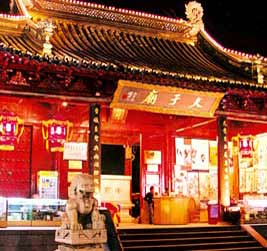
When someone mentions Nanjing, you probably think of an old-fashioned city that was the capital city of six ancient dynasties. Many people agree with the saying that Nanjing is a city with a nostalgia complex. A couple of days will allow visitors to experience the city's nostalgic ambience.
One of the most popular places to visit is the Confucius Temple, which was founded during the Song Dynasty in the early 11th century. It was initially an imperial academy but later changed to a center of culture and commerce. Many cities and towns in China have temples named after Confucius, one of China's great thinkers, but the Confucius Temple in Nanjing is particularly special because of its age and history making it an essential place to visit. Teahouses, restaurants, movie theaters, opera theaters, peddler markets and many other kinds of recreational facilities attract and entertain visitors and local residents. There are also many delicious snacks to satisfy your taste buds. Shredded bean curd, crab-meat dumplings and fried quails are a sensual delight to both your sight and taste.
Confucius Temple is located on the north bank of the Qinhuai River, which has been the source of many poems and stories. The river is well-known for its picturesque scenery in ancient times with houses and halls on both sides of the river, green windows and red doors reflected in the moonlit rippled water. The sounds of water lapping gently against boats and oars create a kind of gentle music. The scenery is especially magnificent on grand occasions with boats lit by beautiful lanterns winding their way like floating, flaming dragons. Fortunately, the city's charming historical scenes were brought back to life in 1985, when the Nanjing Municipal Government rebuilt the streets in the style of the Ming and Qing dynasties.
Today, next to "Qinhuai Home," a traditional Chinese-style hotel built on the river, you can enjoy a whole lot of things. You are sure to be intoxicated by the area's many sights and sounds. The river is lined with teahouses, restaurants, and stores; crowded with boats, bright lanterns in the evenings, music and laughter. Now it has become the most unique cultural area with distinctive local characteristics that combine commerce, tourism and folklore.
Then you have to savor the local architecture. Dr. Sun Yat-sen's Mausoleum, which is widely acknowledged as a masterpiece of the Chinese palatial style, is situated at the foot of the second peak of Mount Zijin. Dr. Sun Yat-sen is regarded by many as modern China's founding father and was buried here in 1929.
Sitting on the mountain's slope, the mausoleum looks majestic and sublime. The vault is more than 700 meters away from the entrance of the mausoleum on the square below. There is a three-tier stone stand upon which a huge bronze ding, an ancient Chinese vessel symbolizing power, perches. Beyond is the 480-meter-long and 50-meter-wide stairway with 392 stairs, leading to the vault. On both sides, tall pine trees, cypress trees and gingko trees guard the way alongside. At the end of the stairway is a huge gate. The tri-arched marble gate is inscribed with four Chinese characters written by Sun, which reads: "The nation is the people's nation and everyone should serve the nation selflessly." Visitors can learn about Sun's life in the hall.
On leaving the mausoleum, travel west and you will see a couple of places harking back to the 1920s and 1930s. The Nanjing Museum and Nanjing Archive were previously buildings used by the Kuomintang administration. If you happen to be on Zhongshan Road North, remember to walk slowly, as the former office of the Kuomintang administration's Ministry of Foreign Affairs was also located there.
Anyway, wherever you go in the city, you can experience the dynamism of a modern metropolis set against a sleepy historic backdrop full of nostalgia. The mix of skyscrapers and old buildings keep you on your toes and leave you with the impression that you are at the crossroads of modernity and history.
Travel tips
The best seasons to visit Nanjing are spring and autumn. Known as the "hot pot" of China, Nanjing is unpleasantly hot in summers.
There are five or six flights from Shenzhen to Nanjing every day. A one-way ticket costs 1,380 yuan (US$166).
There is no direct train from Shenzhen to Nanjing.
There are several hotels on Taiping Road South, which is near the Confucius Temple and some other tourist sites. The ordinary hotel rate, for independent travelers, is 100-150 yuan for a standard room.
The biggest shopping center in Nanjing is Xinjiekou. Wood carvings and colorful pebbles are famous and popular souvenirs to buy for your family and friends.
Click here to see local weather.
Click here to make reservations.
(Shenzhen Daily November 1, 2004)
|

